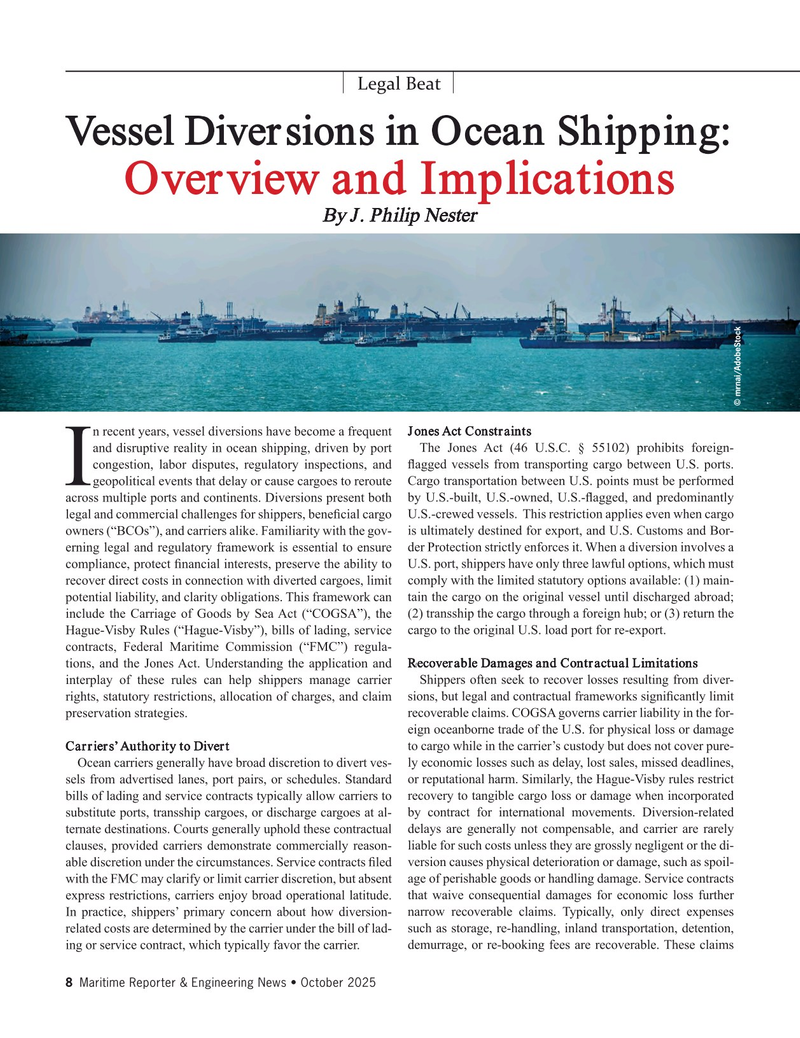
Page 8: of Maritime Reporter Magazine (October 2025)
Read this page in Pdf, Flash or Html5 edition of October 2025 Maritime Reporter Magazine
Legal Beat
Vessel Diversions in Ocean Shipping:
Overview and Implications
By J. Philip Nester © mrnai/AdobeStock n recent years, vessel diversions have become a frequent Jones Act Constraints and disruptive reality in ocean shipping, driven by port The Jones Act (46 U.S.C. § 55102) prohibits foreign- congestion, labor disputes, regulatory inspections, and ? agged vessels from transporting cargo between U.S. ports.
Igeopolitical events that delay or cause cargoes to reroute Cargo transportation between U.S. points must be performed across multiple ports and continents. Diversions present both by U.S.-built, U.S.-owned, U.S.-? agged, and predominantly legal and commercial challenges for shippers, bene? cial cargo U.S.-crewed vessels. This restriction applies even when cargo owners (“BCOs”), and carriers alike. Familiarity with the gov- is ultimately destined for export, and U.S. Customs and Bor- erning legal and regulatory framework is essential to ensure der Protection strictly enforces it. When a diversion involves a compliance, protect ? nancial interests, preserve the ability to U.S. port, shippers have only three lawful options, which must recover direct costs in connection with diverted cargoes, limit comply with the limited statutory options available: (1) main- potential liability, and clarity obligations. This framework can tain the cargo on the original vessel until discharged abroad; include the Carriage of Goods by Sea Act (“COGSA”), the (2) transship the cargo through a foreign hub; or (3) return the
Hague-Visby Rules (“Hague-Visby”), bills of lading, service cargo to the original U.S. load port for re-export.
contracts, Federal Maritime Commission (“FMC”) regula- tions, and the Jones Act. Understanding the application and Recoverable Damages and Contractual Limitations interplay of these rules can help shippers manage carrier Shippers often seek to recover losses resulting from diver- rights, statutory restrictions, allocation of charges, and claim sions, but legal and contractual frameworks signi? cantly limit preservation strategies. recoverable claims. COGSA governs carrier liability in the for- eign oceanborne trade of the U.S. for physical loss or damage
Carriers’ Authority to Divert to cargo while in the carrier’s custody but does not cover pure-
Ocean carriers generally have broad discretion to divert ves- ly economic losses such as delay, lost sales, missed deadlines, sels from advertised lanes, port pairs, or schedules. Standard or reputational harm. Similarly, the Hague-Visby rules restrict bills of lading and service contracts typically allow carriers to recovery to tangible cargo loss or damage when incorporated substitute ports, transship cargoes, or discharge cargoes at al- by contract for international movements. Diversion-related ternate destinations. Courts generally uphold these contractual delays are generally not compensable, and carrier are rarely clauses, provided carriers demonstrate commercially reason- liable for such costs unless they are grossly negligent or the di- able discretion under the circumstances. Service contracts ? led version causes physical deterioration or damage, such as spoil- with the FMC may clarify or limit carrier discretion, but absent age of perishable goods or handling damage. Service contracts express restrictions, carriers enjoy broad operational latitude. that waive consequential damages for economic loss further
In practice, shippers’ primary concern about how diversion- narrow recoverable claims. Typically, only direct expenses related costs are determined by the carrier under the bill of lad- such as storage, re-handling, inland transportation, detention, ing or service contract, which typically favor the carrier. demurrage, or re-booking fees are recoverable. These claims 8 Maritime Reporter & Engineering News • October 2025
MR #10 (1-17).indd 8 MR #10 (1-17).indd 8 10/1/2025 1:30:51 PM10/1/2025 1:30:51 PM

 7
7

 9
9
